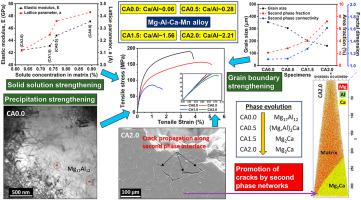Materials Science and Engineering: A ( IF 6.1 ) Pub Date : 2020-09-22 , DOI: 10.1016/j.msea.2020.140322 S. Sanyal , M. Paliwal , T.K. Bandyopadhyay , S. Mandal

|
In the present investigation, the microstructure and phase evolution, and their implications on the mechanical properties for different Ca/Al ratios (within ~0.06–2.21, wt.%) in lean as-cast Mg–Al–Ca–Mn alloys are experimentally studied. Further, the evolution of the second phases and the matrix phase in different alloy compositions have been estimated through thermodynamic calculations using Scheil conditions. The primary phase in all these alloys is a solid solution of hcp Mg with the other elements like Al and Ca. Apart from the fine Al8Mn5 particles present in all the compositions, the major eutectic second phase is γ-Mg17Al12 in the specimen with Ca/Al ratio ~0.06, C36-(Mg,Al)2Ca in the specimen with Ca/Al ratio ~0.28 and C14–Mg2Ca in the specimens with Ca/Al ratio ~1.56 and ~2.21. The area fraction of the eutectic second phases increases from ~2.1 to ~7.2% with the Ca/Al ratio, with a concomitant increase in its network connectivity as confirmed through fractal analysis. Contrarily, the lattice parameters (both a and c) and the elastic modulus (E) of the matrix phase decrease with increasing Ca/Al ratio, due to the decreasing concentration of solute atoms in the matrix. Therefore, the specimen with the minimum Ca/Al ratio (~0.06) attains maximum strength (YS ~130 MPa, UTS ~183 MPa), primarily owing to solid solution strengthening from higher solute content and precipitation strengthening from fine γ-Mg17Al12 particles. The large fraction and strong networks of hard and brittle Mg2Ca phase promote cracks during tensile deformation and deteriorates the ductility (≤1.6%) and work hardening response in the alloys with higher Ca/Al ratios (≥1.56).
中文翻译:

钙/铝比大范围影响下的贫铸Mg-Al-Ca-Mn合金的组织,相和力学性能的演变
在本研究中,通过实验研究了贫铸态Mg-Al-Ca-Mn合金中不同Ca / Al比(约0.06-2.21 wt。%)的微观组织和相演变及其对力学性能的影响。研究。此外,已经通过使用Scheil条件的热力学计算来估计第二相和基体相在不同合金组成中的演变。所有这些合金中的主要相都是hcp Mg与其他元素(如Al和Ca)的固溶体。除了细铝8的Mn 5颗粒存在于所有的组合物中,主要的共晶第二相是γ-Mg系17的Al 12在用Ca / Al比在试样〜0.06,C36-(镁,铝)2Ca / Al比〜0.28和C14–Mg 2的Ca样品Ca / Al比〜1.56和〜2.21的样品。共晶第二相的面积分数随着Ca / Al的比值从〜2.1%增加到〜7.2%,并通过分形分析证实其网络连通性随之增加。相反,由于基质中溶质原子的浓度降低,基质相的晶格参数(a和c)和弹性模量(E)随着Ca / Al比的增加而降低。因此,具有最小Ca / Al比(〜0.06)的样品可达到最大强度(YS〜130 MPa,UTS〜183 MPa),这主要是由于较高的溶质含量导致固溶强化和细的γ-Mg沉淀强化17 Al 12颗粒。Ca / Al比率较高(≥1.56)的合金中,较大的分数和坚硬的Mg 2 Ca相网络会在拉伸变形过程中导致裂纹,并降低延展性(≤1.6%)和加工硬化响应。











































 京公网安备 11010802027423号
京公网安备 11010802027423号